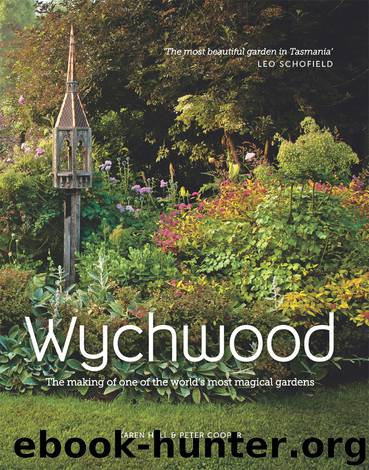Wychwood by Karen Hall

Author:Karen Hall
Language: eng
Format: epub
Publisher: Allen & Unwin
Clockwise from top left: Frost sits atop the seed heads of Phlomis russelliana; A huge Gunnera manicata leaf, gently touched by the first autumn frost; The pretty spherical flower heads of the globe thistle (Echinops ritro) on a dewy summer morning.
The spent flower heads of some perennials are well worth enjoying before they are cut down — and can add to a garden’s interest well into winter.
So to save you from similar confusion, I’ll try to explain the art of cutting back (apologies if I get a little technical here). There are many different types of plants: trees, shrubs, grasses, and also annuals (plants that only survive one growing season, such as petunias). There are also perennials, which live for longer than one growing season, often many years, but are generally not woody like shrubs. Some of them are evergreen, but others are what are known as ‘herbaceous perennials’. These are plants that, despite living for a few years, have an annual cycle that sees them die back after flowering (usually in winter) to a ‘crown’ just under the surface of the soil. I assume this is, in part, a defence mechanism to help them survive a cold winter. It also gives them a bit of a rest to regroup and restore their energy.
When these plants die back, they leave behind their decaying flowering stems, and these need cutting back annually or they can look decidedly scruffy. I presume eventually they would just wither and disappear, but an annual cut-back tidies up the garden and gets it ready for the next annual growth. Some herbaceous perennials look better than others in their decaying phase, and we often leave these ones for their decorative effect in the winter garden. Classics such as echinacea spring to mind: their drying stems are quite robust and tend to not fall over until the last minute, and their seed heads are a delight, especially when delicately laced with early-morning frost.
Some people take care of their cut-back in late autumn as soon as growth is over and the rot sets in. These are often the same people who religiously rake up the autumn leaves the moment they drop — tidy, organised people. We don’t fall into that category. We love autumn leaves and leave them well into winter, at which time we just rake them onto the garden beds. We leave our major cut-back until late winter so we can enjoy the dead and dying stems of the perennials and grasses. Either way, a large garden can produce copious amounts of organic matter, which if you are diligent can be made into wonderful compost. So they tell me.
In our early years, when the garden was quite young and our plants still quite small, we used a lot of mulch … an awful lot. In the greediest year, we used twenty huge round bales of pea straw and then had to source another sixty square bales to finish off. Now that our garden has grown and the
Download
This site does not store any files on its server. We only index and link to content provided by other sites. Please contact the content providers to delete copyright contents if any and email us, we'll remove relevant links or contents immediately.
Kathy Andrews Collection by Kathy Andrews(11689)
The remains of the day by Kazuo Ishiguro(8763)
Paper Towns by Green John(5032)
Spare by Prince Harry The Duke of Sussex(5004)
The Body: A Guide for Occupants by Bill Bryson(4898)
Industrial Automation from Scratch: A hands-on guide to using sensors, actuators, PLCs, HMIs, and SCADA to automate industrial processes by Olushola Akande(4861)
Machine Learning at Scale with H2O by Gregory Keys | David Whiting(3988)
Be in a Treehouse by Pete Nelson(3886)
Harry Potter and the Goblet Of Fire by J.K. Rowling(3749)
Never by Ken Follett(3718)
Goodbye Paradise(3673)
Into Thin Air by Jon Krakauer(3271)
The Remains of the Day by Kazuo Ishiguro(3265)
The Cellar by Natasha Preston(3229)
The Genius of Japanese Carpentry by Azby Brown(3199)
Fairy Tale by Stephen King(3164)
120 Days of Sodom by Marquis de Sade(3126)
Drawing Shortcuts: Developing Quick Drawing Skills Using Today's Technology by Leggitt Jim(2965)
The Man Who Died Twice by Richard Osman(2965)
